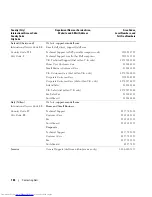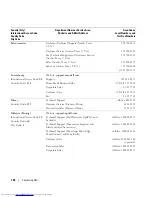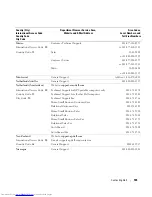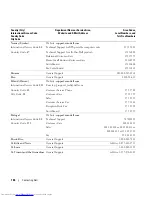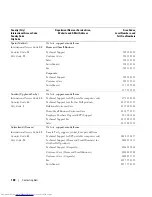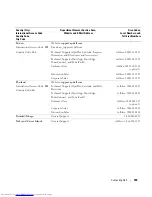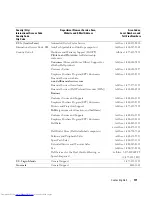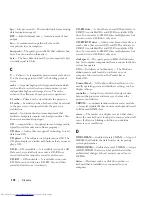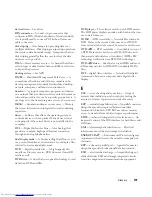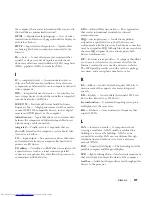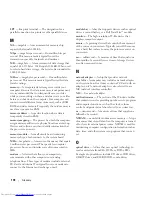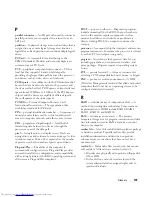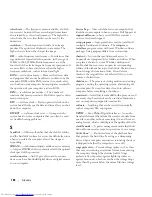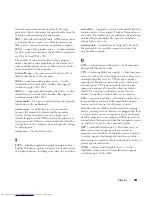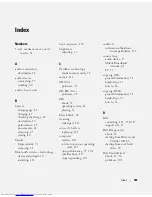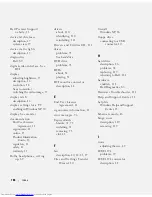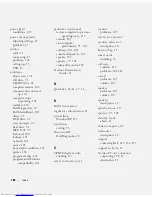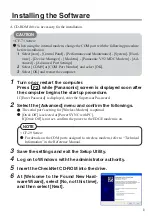
176
Glossary
expansion card
— A circuit board that installs in an
expansion slot on the system board in some computers,
expanding the capabilities of the computer. Examples
include video, modem, and sound cards.
expansion slot
— A connector on the system board (in
some computers) where you insert an expansion card,
connecting it to the system bus.
ExpressCard
— A removable I/O card adhering to the
PCMCIA standard. Modems and network adapters are
common types of ExpressCards. ExpressCards support
both the PCI Express and USB 2.0 standard.
Express Service Code
— A numeric code located on a
sticker on your Dell™ computer. Use the Express Service
Code when contacting Dell for assistance. Express Service
Code service may not be available in some countries.
extended display mode
— A display setting that allows
you to use a second monitor as an extension of your
display. Also referred to as
dual display mode
.
extended PC Card
— A PC Card that extends beyond the
edge of the PC Card slot when installed.
F
Fahrenheit
— A temperature measurement scale where
32° is the freezing point and 212° is the boiling point of
water.
FCC
— Federal Communications Commission — A U.S.
agency responsible for enforcing communications-related
regulations that state how much radiation computers and
other electronic equipment can emit.
floppy
— An electromagnetic form of storage media. Also
known as a floppy diskette or a floppy disk.
floppy drive
— A disk drive that can read and write to
floppy disks.
folder
— A term used to describe space on a disk or drive
where files are organized and grouped. Files in a folder can
be viewed and ordered in various ways, such as
alphabetically, by date, and by size.
format
— The process that prepares a drive or disk for file
storage. When a drive or disk is formatted, the existing
information on it is lost.
FSB
— front side bus — The data path and physical
interface between the processor and RAM.
FTP
— file transfer protocol — A standard Internet
protocol used to exchange files between computers
connected to the Internet.
G
G
— gravity — A measurement of weight and force.
GB
— gigabyte — A measurement of data storage that
equals 1024 MB (1,073,741,824 bytes). When used to
refer to hard drive storage, the term is often rounded to
1,000,000,000 bytes.
GHz
— gigahertz — A measurement of frequency that
equals one thousand million Hz, or one thousand MHz.
The speeds for computer processors, buses, and interfaces
are often measured in GHz.
graphics mode
— A video mode that can be defined as
x
horizontal pixels by
y
vertical pixels by
z
colors. Graphics
modes can display an unlimited variety of shapes and
fonts.
GUI
— graphical user interface — Software that interacts
with the user by means of menus, windows, and icons.
Most programs that operate on the Windows operating
systems are GUIs.
H
hard drive
— A drive that reads and writes data on a hard
disk. The terms hard drive and hard disk are often used
interchangeably.
heat sink
— A metal plate on some processors that helps
dissipate heat.
help file
— A file that contains descriptive or
instructional information about a product. Some help
files are associated with a particular program, such as
Help
in Microsoft Word. Other help files function as stand-
alone reference sources. Help files typically have a
filename extension of
.hlp
or
.chm
.
hibernate mode
— A power management mode that saves
everything in memory to a reserved space on the hard
drive and then turns off the computer. When you restart
Summary of Contents for INSPIRON PP05XB
Page 1: ...w w w d e l l c o m s u p p o r t d e l l c o m Dell XPS M1710 Owner s Manual Model PP05XB ...
Page 28: ...28 A Tour of Your Computer ...
Page 36: ...36 Setting Up Your Computer ...
Page 50: ...50 Dell QuickSet Features ...
Page 77: ...Using Cards 77 1 smart card slot 2 smart card 3 ExpressCard slot 1 2 3 ...
Page 78: ...78 Using Cards ...
Page 116: ...116 Troubleshooting ...
Page 144: ...144 Specifications ...
Page 172: ...172 Contacting Dell ...
Page 184: ...184 Glossary ...
Page 190: ...90 Index 190 Index ...

